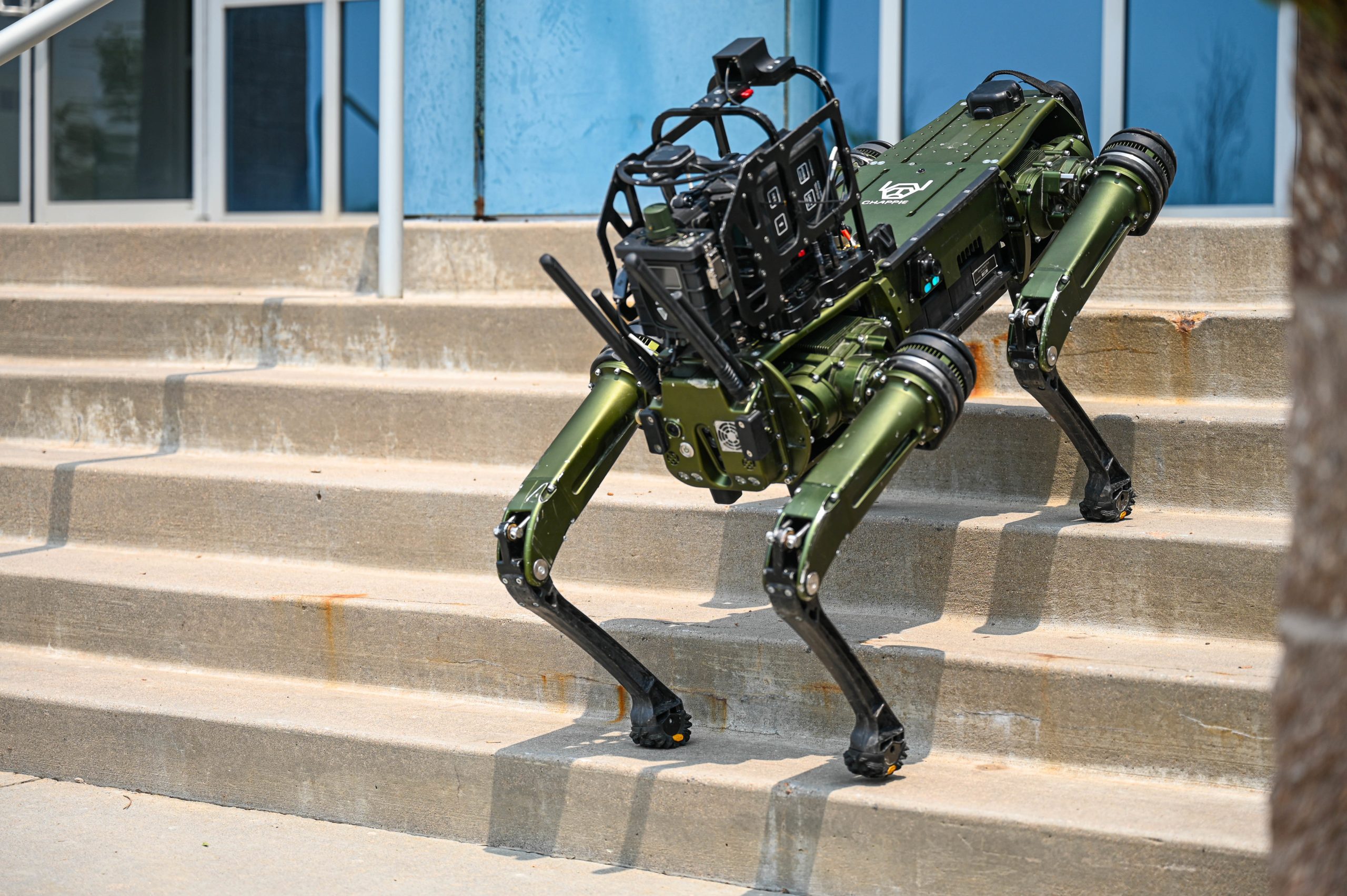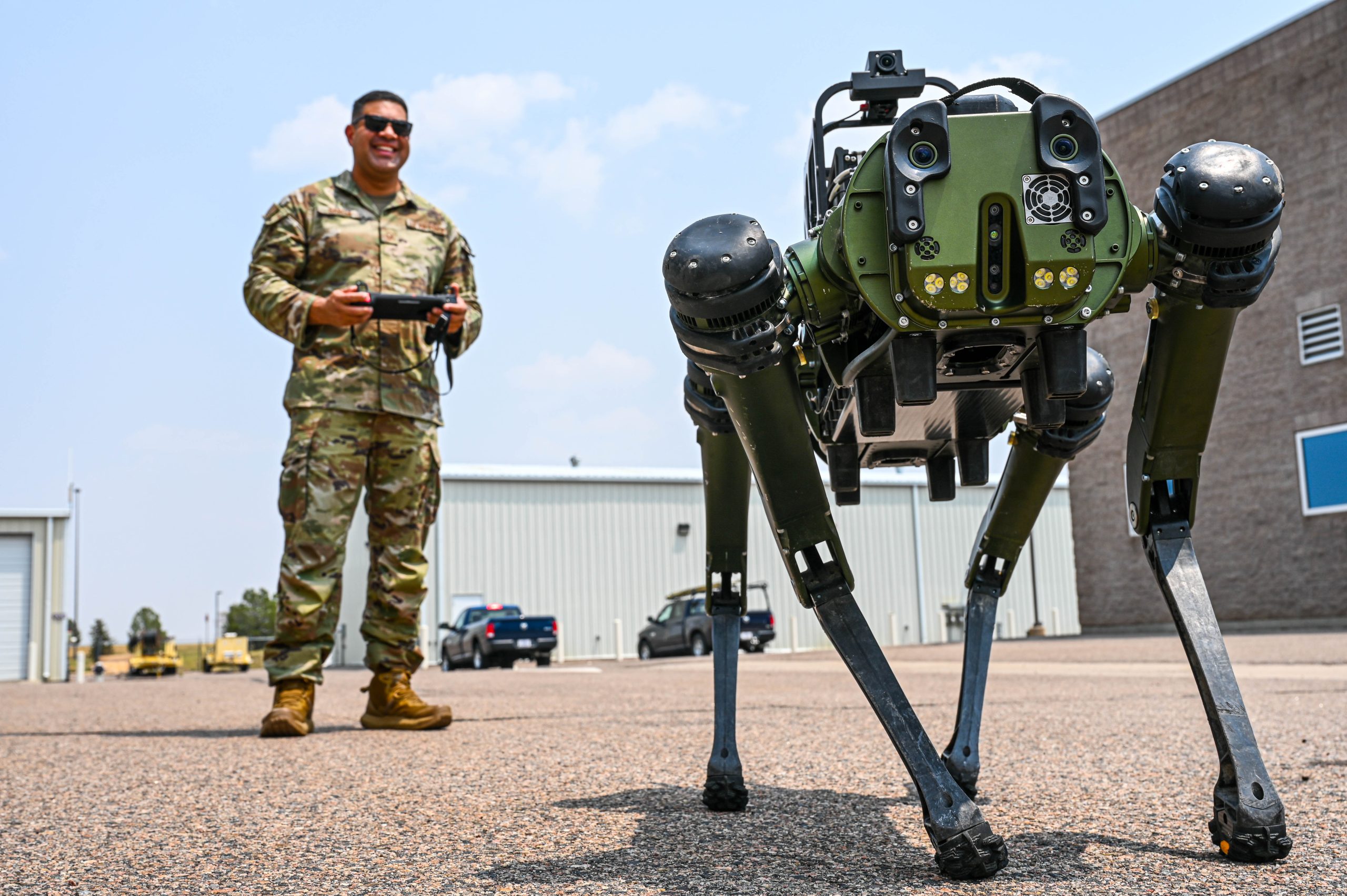As threats from chemical, biological, radiological, and nuclear (CBRN) agents become increasingly sophisticated, so must the technology used to combat them. Leading the way in this domain is CHAPPIE, an innovative quadrupedal unmanned ground vehicle (QUGV) stationed at Buckley Space Force Base.
One of only two in the Department of Defense (DoD) customized specifically for CBRN defense, CHAPPIE is far more than a mechanical marvel. It represents a shift towards agile, user-driven innovation, powered by the Department of the Air Force’s AFWERX initiative, and promises a new level of precision, safety, and responsiveness in military operations.
But beyond its impressive technical capabilities, CHAPPIE raises questions and offers insights into the future security impacts of advanced robotic technology in defense.
The Evolution of CBRN Defense Technology
CBRN threats, particularly from chemical and biological weapons, pose significant challenges due to their unpredictable and often devastating nature.
Traditional methods of CBRN response have relied heavily on human-operated systems and protective gear, which expose military personnel to high-risk environments. In recent years, the increasing complexity and potential lethality of CBRN threats have driven a search for solutions that minimize human exposure.
Introducing CHAPPIE and similar QUGVs in CBRN operations signals a major transformation in this field. With advanced sensor systems, remote operational capabilities, and autonomous navigation, CHAPPIE can perform functions that previously required direct human intervention.
From detecting airborne toxins to scanning for radiological materials, CHAPPIE’s technology reduces risk while enhancing operational precision.
CHAPPIE’s design and functionality stem from a clear vision: to prioritize the safety of human operators while expanding the technological scope of CBRN defense.
The project’s swift development, supported by AFWERX’s agile approach, marks a significant shift in how defense technology is researched, funded, and implemented, with end-users actively participating in the customization process.

AFWERX: The Power Behind Agile Defense Innovation
AFWERX, the Department of the Air Force’s innovation arm, is at the core of CHAPPIE’s development. AFWERX accelerates the transition of high-potential technology to the field by connecting Airmen, Guardians, and industry partners.
By embracing a user-driven, collaborative approach, AFWERX enables personnel from across the ranks to work closely with private-sector experts, ensuring that new technologies meet the immediate and practical needs of military operations.
For Master Sgt. Dominic Garcia, the driving force behind CHAPPIE’s development, this approach has been instrumental.
Garcia’s vision for a safer and more effective CBRN response system began after a deployment to Syria, where he encountered the limitations of conventional detection methods.
Applying for a Small Business Innovation Research Grant in 2022, Garcia secured $1.24 million to prototype CHAPPIE. Within 20 months, the QUGV reached 90% of its operational goal, showcasing the efficiency of AFWERX’s model and the potential of rapid prototyping in defense.
Revolutionizing Field Operations
CHAPPIE is not just a tool but a multi-capable asset with a vast array of features. Its ability to remotely deploy detectors from existing military inventories distinguishes it from other robotic systems, offering adaptability to various mission parameters. In high-risk CBRN environments, CHAPPIE can gather real-time data without putting personnel in harm’s way, delivering a critical advantage in both responsiveness and safety.
Key features of CHAPPIE include:
- Remote CBRN Sensing: CHAPPIE integrates seamlessly with current DoD CBRN detectors, providing remote detection and identification of hazardous materials. This capability ensures that accurate data can be gathered and analyzed without requiring human operators in dangerous environments.
- Autonomous Navigation and Adaptability: Equipped with advanced navigation systems, CHAPPIE can operate independently in diverse terrains, enabling it to support missions in complex and hostile environments.
- Sensor Integration and Future AI Enhancements: CHAPPIE’s modular design allows for the integration of cutting-edge sensor technologies. Future AI-driven upgrades will enable it to detect emerging threats with greater speed and precision, enhancing its role as a key component of CBRN defense.
These capabilities allow CHAPPIE to adapt to various mission demands, reflecting a new era in military technology where adaptability and multifunctionality are prioritized.
Security Implications of QUGV Technology in Modern Defense
The deployment of CHAPPIE highlights both the security benefits and the potential risks associated with advanced robotic systems in defense. On one hand, CHAPPIE’s capabilities offer a level of safety and efficiency that was previously unattainable.
By reducing human exposure in hazardous environments, it directly contributes to the well-being of military personnel. Moreover, CHAPPIE’s autonomous functions ensure that critical operations can proceed even in the absence of human control, enhancing mission resilience.
However, the integration of such technology also raises critical security considerations. Autonomous systems operating in sensitive areas must be safeguarded against cyber threats.
In a high-stakes environment, any vulnerability in CHAPPIE’s systems could have serious consequences, potentially compromising the success of critical missions or even leading to unauthorized access by adversaries.
To address these concerns, CHAPPIE’s developers have prioritized cybersecurity protocols, creating a resilient platform designed to withstand hacking attempts and ensure operational integrity.
Additionally, as CHAPPIE and similar technologies are adopted more widely, military strategies will likely shift to incorporate a blend of human and robotic teams.
This integration could redefine roles within military units, demanding new training and operational protocols to manage interactions between humans and autonomous systems effectively.

Advancing Strategic Preparedness in the Great Power Competition
CHAPPIE’s deployment comes at a time when global defense dynamics are increasingly defined by the concept of Great Power Competition.
As the United States seeks to maintain a strategic edge over potential adversaries, investments in advanced technology like CHAPPIE are critical.
In CBRN defense, where speed and precision are essential, CHAPPIE’s capabilities align with the broader U.S. strategy of technological dominance.
Looking ahead, CHAPPIE’s continued development will focus on enhancing its agility and sensor accuracy, further expanding its utility in defense operations.
As the DoD explores new ways to adapt to rapidly evolving threats, CHAPPIE’s success could serve as a model for future projects, illustrating the benefits of a user-driven, agile approach to defense innovation.

The Human Element of Technological Advancement
While CHAPPIE is a remarkable achievement in robotics, its success is deeply tied to the vision and dedication of individuals like Master Sgt. Dominic Garcia.
Garcia’s emphasis on empowering service members highlights a significant aspect of defense innovation: the human element.
By recognizing and fostering the unique talents and insights of personnel, the military can drive grassroots innovation, ensuring that ideas originating from field experience are developed into practical solutions.
Garcia’s message resonates across the DoD, calling for a culture of innovation that transcends rank and hierarchy.
His advocacy for a collaborative approach to technology development is reflected in CHAPPIE’s design, which directly incorporates input from end-users.
By promoting an inclusive and supportive environment for innovation, the military can tap into the collective expertise of its personnel, paving the way for future advancements.
CHAPPIE’s Role in the Future of Military Robotics
CHAPPIE’s impact on CBRN defense represents only the beginning of its potential applications in the military.
As advancements in artificial intelligence, sensor technology, and robotics continue, CHAPPIE’s role could expand to include new capabilities, from intelligence gathering to logistical support.
Its versatility and modular design make it an ideal platform for further innovation, providing a testbed for emerging technologies that could redefine the operational landscape of the armed forces.
Moreover, CHAPPIE’s deployment has broader implications for the future of military robotics. By establishing a successful proof of concept for robotic systems in high-risk operations, CHAPPIE opens the door to a new generation of QUGVs tailored for various defense applications.
These developments could ultimately lead to a more integrated military force, where humans and robots collaborate seamlessly to achieve mission objectives.
CHAPPIE represents a major leap forward in CBRN defense and a powerful symbol of the U.S. military’s commitment to technological innovation.
Its capabilities in remote sensing, autonomous navigation, and adaptability underscore the importance of advanced robotics in modern warfare, providing a safer and more effective approach to addressing CBRN threats.
As CHAPPIE continues to evolve, it exemplifies the transformative potential of defense technology, illustrating how strategic investments in robotics can enhance operational efficiency and reinforce national security.
The project’s success is a testament to the power of innovation within the Air and Space Forces, as well as the value of a collaborative approach that empowers service members to shape the future of military technology.
Ultimately, CHAPPIE is more than a machine—it is a legacy of innovation, a commitment to safety, and a promise of resilience in an era defined by complex security challenges. As the U.S. faces new and evolving threats, CHAPPIE stands as a beacon of adaptability and a reminder of the role that technological ingenuity will play in securing the nation’s future.



